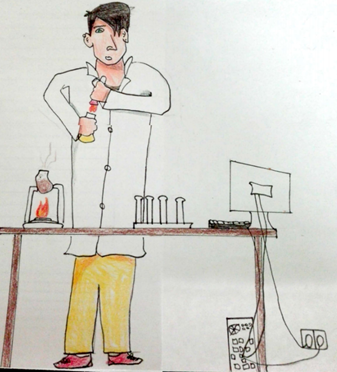Images of People who Do Science: The Case of a Group of Students from Villa Lugano
Main Article Content
Abstract
The purpose of this work is to explore the image of scientists in incoming students at a Technical School of Villa Lugano from the University of Buenos Aires testing modifications of the traditional methodological designs. 74 students were asked to do drawings and complete a daily schedule of a person who does science. Most of the drawings were male scientists wearing lab aprons and working alone, who, according to the agendas, spend most of their time working. Male students assigned greater relative importance to work activities, while female students gave more importance to housework. Although it is still necessary to refine the proposed methodology, these results show the potential of the agendas as a tool to investigate aspects of science as a dynamic process.
Downloads
Article Details

This work is licensed under a Creative Commons Attribution-NonCommercial-ShareAlike 4.0 International License.
Aquellos autores/as que tengan publicaciones con esta revista, aceptan los términos siguientes:- Los autores/as conservarán sus derechos de autor y garantizarán a la revista el derecho de primera publicación de su obra, el cuál estará simultáneamente sujeto a la Licencia de reconocimiento de Creative Commons que no se permite un uso comercial de la obra original ni de las posibles obras derivadas, la distribución de las cuales se debe hacer con una licencia igual a la que regula la obra original.
- Los autores/as podrán adoptar otros acuerdos de licencia no exclusiva de distribución de la versión de la obra publicada (p. ej.: depositarla en un archivo telemático institucional o publicarla en un volumen monográfico) siempre que se indique la publicación inicial en esta revista.
- Se recomienda a los autores/as difundir su obra a través de Internet (p. ej.: en archivos telemáticos institucionales o en su página web) después del proceso de publicación, lo cual puede producir intercambios interesantes y aumentar las citas de la obra publicada. (Véase El efecto del acceso abierto).
References
Adúriz-Bravo, A., Dibarboure, M. y Ithurralde, S. (coord.) (2013). El quehacer del científico al aula: Pistas para pensar. Montevideo: Fondo Editorial QuEduca.
Caamaño, A. y Vilches, A. (2020). Nuestros Seminarios Ibéricos e Iberoamericanos CTS en Aveiro. Boletín de la AIA-CTS. Especial Veinte años de Seminarios Ibéricos/Iberoamericanos CTS, (12): 90-98.
Campanario, J. M., Moya, A. y Otero, J. C. (2001). Invocaciones y usos inadecuados de la ciencia en la publicidad. Enseñanza de las ciencias, 19(1): 45-56.
Chambers, D. (1983). Stereotypic Images of the Scientist: The Draw-A-Scientist Test. Science Education, 67(2): 255-65.
Farland-Smith, D. (2009). How Does Culture Shape Students’ Perceptions of Scientists?Cross- National Comparative Study of American and Chinese Elementary Students. Journal of Elementary Science Education, 21(4): 23–42.
Farland-Smith, D. (2012). Development and field test of the modified Draw-a-Scientist Test and the Draw-a-Scientist Rubric. School Science and Mathematics, 112(2): 109–116. https://doi.org/10.1111/j.1949-8594.2011.00124.x
Finson, K. D., Beaver, J. B. y Cramond, B. L. (1995). Development and field test of a checklist for the draw-a-scientist test. School Science and Mathematics, 95(4): 195–205. https://doi.org/10.1111/j.1949-8594.1995.tb15762.x
Gallego, P. (2007). Imagen popular de la ciencia transmitida por los cómics. Eureka sobre enseñanza y divulgación de las ciencias, 4 (1):141-151.
Lamimpää,J., Vesterinen, V. y Puutio, K. (2020). Draw-A-Science-Comic: exploring children’s conceptions by drawing a comic about science. Research in Science & Technological Education. doi.org/10.1080/02635143.2020.1839405
Losh, S. C., Wilke, R. y Pop, M. (2008). Some methodological issues with “Draw a Scientist Tests” among young children. International Journal of Science Education, 30(6): 773–792. https://doi.org/10.1080/09500690701250452
Manzoli, F. (2006). Children’s perceptions of science and scientists: a case study based on drawings and story-telling. International Conference on Public Communication of Science and Technology.
Maoldomhnaigh, M. Ó., Mhaoláin, V. N. (1990). The perceived expectation of the administrator as a factor affecting the sex of scientists drawn by early adolescent girls. Research in Science and Technological Education, 8: 69–74. https://doi.org/10.1080/0263514900080106
Maxim, P. (2002). Métodos cuantitativos aplicados a las ciencias sociales. Mexico: Oxford University Press Harla.
Mead, M. y Métraux, R. (1957). Image of the Scientist among High-School Students. A Pilot Study. Science, 126: 384-90.
Porro, S. (2017). La educación CTS: una posible solución al fracaso escolar en la formación de ciudadanía. En R. Cervini (Ed) El fracaso escolar. Diferentes perspectivas disciplinarias (pp.143-155). Universidad Nacional de Quilmes, Argentina. Recuperado a partir de http://www.unq.edu.ar/advf/documentos/59d4d534c9c54.pdf
Pujalte, A., (2014). Las imágenes de ciencia del profesorado: de la imagen discursiva a la enactiva. Universidad Nacional de Quilmes, Buenos Aires, Argentina. Disponible en https://ridaa.unq.edu.ar/bitstream/handle/20.500.11807/986/TD_2014_pujalte_012.pdf?sequence=1&isAllowed=y
Pujalte, A., Bonan, L., Porro, S. y Adúriz-Bravo, A. (2014). Las imágenes inadecuadas de ciencia y de científico como foco de la naturaleza de la ciencia: estado del arte y cuestiones pendientes. Ciência & Educação, 20: 535-548. https://doi.org/10.1590/1516-73132014000300002
Pujalte, A. P., Gangui, A., Adúriz-Bravo, A. (2017). Las imágenes de científico en cuentos de ficción escritos por jóvenes estudiantes. Enseñanza de las ciencias, Número Extra: 3525-3530. https://ddd.uab.cat/record/183873
Rodríguez Gómez, G., Gil Flores, G. y García Jiménez, G. (1999). Metodología de la investigación cualitativa. Buenos Aires: Ediciones Aljibe.
Toma, R., Freca, M. y Orozco, M. (2018). Una revisión del protocolo Draw-a-Scientist-Test (DAST). Revista Eureka sobre Enseñanza y Divulgación de las Ciencias, 15(3): 3104-1-310-18. https://doi.org/10.25267/Rev_Eureka_ensen_divulg_cienc.2018.v15.i3.3104
Vendrasco, N., Maturana, J., Gallardo, F., Guzmán, E., y Santibáñez, D. (2017). Campamentos científicos: transformando la visión de científicos en estudiantes chilenos. Enseñanza de las ciencias, (Número Extra): 1679-1684.

